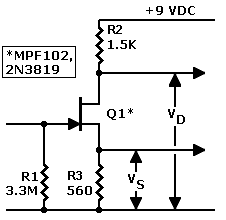Spread in FET Specs
|
COPE BY TWEAKING. If you prefer, follow Tillman's advice and discard FETs that don't bias right. If you toss good parts, though, you're throwing away money! Why not just make those leftover FETs work by tweaking the source resistor? Doing that adjusts the bias. By adjusting bias, you can even improve performance of FETs that are close to the mark. See How to Tweak the Source Resistor. MY TESTS. I ran tests of comparable JFETs. For the tests, I used a plugboard. I wired up a nine-volt circuit for the 2N3819. Then I copied the circuit for the MPF102. In succession, I plugged 11 devices into each circuit. Powering on the circuit, I checked drain voltage drop (Vd) and source voltage (Vs) drop. Test results appear in the nearby table. TEST RESULTS. Surprise! All of the tested devices would probably work in the JFET preamplifier circuit. Yet all would not work equally well. The best devices have a Vd in the ideal Vd range, 5 to 5.5 volts. For this circuit, the formula below computes the ideal Vd voltage. This formula provides an approximate result, not an exact result... |
|
|||||||||||||||||||||||||||||||||
4.5 + (0.5 * Vs) volts
DRAIN VOLTAGE TOLERANCE. Note that each JFET has its own ideal Vd voltage. For the parts in the table above, the ideal ranges from 5 to 5.5 volts. If you're within 10 percent of the ideal, then you're fine. Even 20 percent isn't bad. For example, look at MPF102 #3. The ideal Vd for this part is 5.21 volts. I measured a Vd of 5.12 volts. This actual Vd is 98 percent of the ideal. I'd settle for that! If you don't like the Vd, you can run a sound test. Or you can just tweak the source resistor. See... Tweak.
BATCH SIMILARITIES. I purchased most of my test devices in the same Mouser order. (The only exception is 2N3819 JFET #11.) Maybe the devices in my order all came from the same batch. I'd expect same-batch JFETs to perform more alike than different-batch JFETs. Anyway, don't assume that my results are typical. I have one 2N3819 with five times the gain of most of my other 2N3819 devices!
Go to Page: 1 2 3 4 5 6 7 FAQ Next
JFET Preamp Pages
- Introduction
- Schematic & Parts
- How It Works
- Spec Spread
- Improve Performance
- MPF102 in Tillman Circuit
- Troubleshooting
- FAQ
